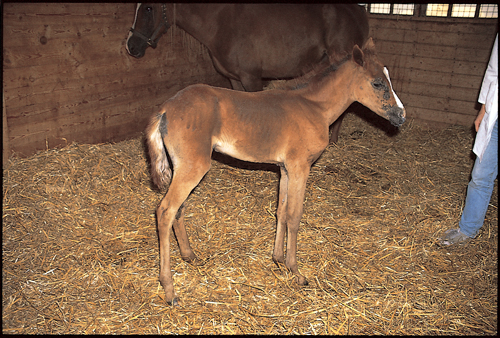Difference between revisions of "Equine Internal Medicine Q&A 16"
Jump to navigation
Jump to search
Ggaitskell (talk | contribs) |
Ggaitskell (talk | contribs) |
||
| Line 24: | Line 24: | ||
*The disease is inherited as an autosomal recessive trait, and heterozygous individuals show no signs. <br><br> | *The disease is inherited as an autosomal recessive trait, and heterozygous individuals show no signs. <br><br> | ||
*Affected foals are usually normal at birth, and signs of infection (especially respiratory infections and pneumonia) become evident at any time between two days and two months depending on the level of passively acquired colostral immunity. | *Affected foals are usually normal at birth, and signs of infection (especially respiratory infections and pneumonia) become evident at any time between two days and two months depending on the level of passively acquired colostral immunity. | ||
| − | |l3= | + | |l3=Lymphocytes - Introduction |
|q4=What are the usual causes of the respiratory infections in this disease? | |q4=What are the usual causes of the respiratory infections in this disease? | ||
|a4=Pneumonia caused by adenovirus, ''Pneumocystis carinii'' and a variety of bacteria are commonly involved. | |a4=Pneumonia caused by adenovirus, ''Pneumocystis carinii'' and a variety of bacteria are commonly involved. | ||
Revision as of 18:16, 5 June 2011
| This question was provided by Manson Publishing as part of the OVAL Project. See more Equine Internal Medicine questions |
A nine-week-old Arabian foal is presented with a history of recurrent respiratory infections characterized by nasal discharge, cough, dyspnoea and pyrexia. The foal was normal at birth, but suffered its first bout of respiratory disease at six weeks of age. Over the previous week it had also developed widespread scaling and alopecic skin lesions, from which Dermatophilus congolensis had been cultured. The foal has also had intermittent diarrhoea. Haematological evaluation revealed a severe lymphopenia (lymphocyte count 0.2x109/l).
| Question | Answer | Article | |
| What is the most likely diagnosis? | Combined immunodeficiency syndrome (CID).
|
Link to Article | |
| How could you confirm this? |
|
Link to Article | |
| What is the aetiology of this disease? |
|
Link to Article | |
| What are the usual causes of the respiratory infections in this disease? | Pneumonia caused by adenovirus, Pneumocystis carinii and a variety of bacteria are commonly involved.
|
Link to Article | |
| How would you treat this foal? | There is no recommended treatment for CID. Bone marrow transplantation has been performed successfully in one affected foal.
|
Link to Article | |
